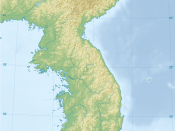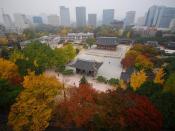Background &Outline
After World War II, a republic was set up in the southern half of the Korean Peninsula while a Communist-style government was installed in the north. During the Korean War (1950-1953), US and other UN forces intervened to defend South Korea from North Korean attacks supported by the Chinese. An armistice was signed in 1953, splitting the Peninsula along a demilitarized zone at about the 38th parallel. Thereafter, South Korea achieved rapid economic growth with per capita income rising to roughly 20 times the level of North Korea. South Korea has maintained its commitment to democratize its political processes. In June 2000, a historic first North-South summit took place between the South's President KIM Dae-jung and the North's leader KIM Chong-il.
Geography
South Korea is located in Eastern Asia, on the southern half of the Korean Peninsula bordering the East Sea/Sea of Japan and the Yellow Sea. South Korea, at 98,480 square kilometers, is slightly larger than the American state of Indiana.
Two hundred and ninety square kilometers of South Korea are occupied by water. The approximate coordinates are 37ð North, 127ð 30 East. Being on a peninsula, the only bordering country is North Korea, where 238 km of boundaries separate them. Much of the country's border is coastline, about 2,413 kilometers.
Climate
Korea has four seasons .In late March spring begins with rainfall at times in a light drizzle to May, The summer is hot, rainy, and humid. The monsoon season begins in late June with the heaviest rain being in July. Autumn is from the end of September to November with dry weather as air blows from the north. The autumn leaves are beautiful. The winter weather is cold with some rain or snow.
People and Population
Korean is descendants of the Mongol tribes yet they...


